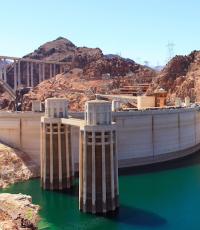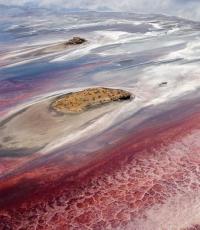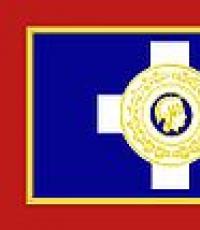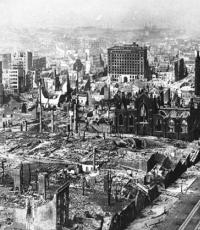Dixon today population. Panorama of Dikson (urban-type settlement). Virtual tour of Dikson (urban-type settlement). Attractions, map, photo, video. Dixon seaport
A hundred years ago, in 1915, a village of the same name was founded on the island of Dikson in the Kara Sea - today it is the northernmost settlement in Russia. Today's Dixon is located partly on the island, and partly - on the coast of the Yenisei Bay of the coast of Peter Chichagov of the Taimyr Peninsula. The parts are separated by a one and a half kilometer strait. The average annual temperature here is -11.4 °C. Today, no more than 700 people live in the village, there is a polar station, but the fish factory no longer exists. They plan to close the only hospital, many houses and outbuildings are abandoned - it costs about three million rubles to demolish a two-story house.
Photographer Aleksey Nikolaev visited Dixon twice, in summer and winter, and shared his beautiful pictures with Bigpiccha.

Monument to the Russian polar explorer Nikifor Begichev. The monument was built in 1964, under it the remains of Begichev, who died in 1926 from scurvy while wintering near the Pyasina River, were reburied.

The inscription on the wall of an abandoned house.

View from the hill to the old building of the port and the unfinished house.

Resident of the village in the all-terrain vehicle GT-T. In winter, Dikson residents move either on Yamaha snowmobiles or on old Soviet tractor transporters that were used to move around the tundra.


View of a part of the village on the coast of the Kara Sea.

Weather station.

The shore of the bay is strewn with old barrels. A man walks on the ice of the bay towards the airport.

The central street of the village, the building of the village club, which is now closed.

Barracks - where residents store boats, tackle and other belongings. Welcome shield with the coat of arms of the city.

The only surviving port crane.


View of Dikson Island. Only one or two people permanently live on the island, the rest were moved to the mainland of the village.

Dixon Airport. At the airport there is a Li-2 plane - as a monument.

Truck - on it from the airport, which is located on the island, luggage is transported to a small boat that delivers everyone to the mainland (when navigation is open).

View of the mainland of the village from the ship.


Picks up some from the port personal transport.

View of the old tug, in the foreground - dismantled antennas.

Pipeline from the lake to the city.

View of the city and the monument to the defenders of Dikson during the Great Patriotic War.


One of the main streets. There are many dogs in the village, all kind and calm. Locals say that they determine by the dogs that a polar bear has entered the village - the animals immediately hide.
Dikson Island has been known to Arctic sailors since the beginning of the 18th century. During the Great Northern Expedition of 1720-1747. in 1738, its participant, navigator Fyodor Minin, called this piece of land the Great North-Eastern. Later it was called Long, and in the XIX century. - Kuzkin Island.
In 1875-1878. the well-known Swedish polar explorer A.-E. Nordenskiöld. Having successfully reached the mouth of the Yenisei through the Kara Sea and considering himself the discoverer of the island, he named the island and the bay after the Swedish entrepreneur Oscar Dixon, who financed the expedition. In 1894, the island was officially given this name.
In 1915, the first house was set up on the island - a radio station for communication with the Great Land of Vilkitsky, who wintered off the coast of Taimyr. Since that time, the official countdown of the life of the village has been conducted.
The first wintering of polar explorers on Dikson Island took place in 1916, when a meteorological station began to operate, transmitting weather reports to Petrograd. Then the tsarist government found funds for this. In 1919, the icebreakers Taimyr, Vaigach and Alexander Nevsky came to Dikson. They left a two-year supply of coal and food at the Red Polar Station.
Since 1929, to meet the needs of hydrography and the Kara expeditions, a permanent air detachment began to be based on Dikson. The development of navigation along the Northern Sea Route contributed to the transformation of the polar station into a regional center.
With the creation of the Northern Sea Route Administration in 1932, the construction of the village, polar stations on the islands and the coast of Taimyr began - first, industrial, residential and auxiliary stations on the island, then on the mainland coast. One-story houses formed streets that were named after the explorers of the North: Sedov, Begichev, Papanin, pilots Chkalov and Vodopyanov, captain Voronin, hunter Tayan.
The names were fixed by the head of the polar station and the resolution of the political department.
The settlement on the mainland, called New Dikson, began its history in 1934 in connection with the construction of the port. Later, a hydrographic base and the headquarters of maritime operations in the western sector of the Arctic appeared here - the coordinator of shipping. In 1939, a coal depot was equipped on Dikson for steamships sailing along the Northern Sea Route. It was at this time that Dixon began to be called the "gates of the Arctic."
In 1941, to ensure the increased volume of cargo turnover, a new berth of the seaport was put into operation. Until now, it has been the main berth of the Dikson seaport.
With the beginning of the Great Patriotic War, the importance of Dixon increased dramatically. All convoys passing through the Kara Sea were formed here. Already after the Great Patriotic War, Dixon was chosen by the military, placing an air defense unit and border guards here.
In 1956, Dikson was assigned to workers' settlements, and in 1957 the island and coastal settlements were merged into one, which became the united center of the Dikson region, separated from Ust-Yenisei.
Since 1957, the construction of two-story buildings began, and since 1976 - five-story buildings. By 1990, Dixon had become a basic settlement with an established infrastructure capable of meeting the needs of any expedition.
The heroic history of the development of the Northern Sea Route is closely connected with the island and the port of Dikson. Well-known scientists, navigators, research pilots of the Arctic have visited here: A.I. Vilkitsky, his son B. Vilkitsky, E. Toll, F. Nansen, R. Amundsen, N. Urvantsev, N. Begichev, O. Schmidt, V. Vize, V. Voronin, B. Chukhnovsky, V. Molokov and others. Dixon surprises with the abundance of erected monuments: Begichev, Tessem, sailors from the North Sea, and others.
|
Flag of Dixon (urban-type settlement) |
Coat of arms of Dixon (urban-type settlement) |
| A country | Russia |
| Subject of the federation | Krasnoyarsk region |
| Municipal area | Taimyrsky Dolgano-Nenetsky District |
| urban settlement | Dixon |
| OKATO code | 04 114 651 |
| car code | 24, 84, 88, 124 |
| Postal codes | 647340, 647341 |
| PGT with | 1956 |
| Population | 676 people (2010) |
| Based | 1915 |
| Coordinates | Coordinates: 73°30′30″ s. sh. 80°31′28″ E / 73.508333° N sh. 80.524444° E (G) (O) (I) 73°30′30″ s. sh. 80°31′28″ E / 73.508333° N sh. 80.524444° E d. (G) (O) (I) |
| Timezone | UTC+8 |
| demonym | Diksonchane, Diksonchanin, Diksonian |
| Telephone code | +7 39152 |
Dikson is an urban-type settlement in the north of the Krasnoyarsk Territory Russia, in the Taimyr Dolgano-Nenets region. Forms the urban settlement of Dikson.
Infrastructure
The northernmost port in Russia. There is an airport (since the autumn of 2010, its operation has been suspended due to the poor condition of the runway, which has greatly hampered the transport connection of the village with other regions). But in December 2010, the operation of the airport was resumed.
Until January 1, 2007, it was the administrative center of the Diksonsky district of the Taimyr Autonomous Okrug.
Now the village is in a deplorable state, the population is 632 inhabitants (2009), while in 2004 1113 people lived on Dikson, and in 1985 - about 5 thousand.
Polar station (since 1916), on the basis of which a radio meteorological center and a geophysical observatory were created. Regional Museum. Formerly one of the important ports of the Northern Sea Route, a bunkering base for the marine fleet, a fish factory.
Story
The settlement was founded in 1915 on the island, the continental part was built later.
The extreme location attracts visitors - Dixon is visited by quite a large number of people, although it is not easy to get there. Creative people have written many songs about Dixon. In one of them, the village is called the "Capital of the Arctic" - now it is the unofficial name of Dixon.
In 1942, not far from the village, there was a clash with the German raider "Admiral Scheer". A monument was erected to the defenders of Dixon.
A monument to N. A. Begichev was also erected.
twinning
In the second half of the 1980s, the life of the Soviet Dixon changed. It was during this period that the idea of “fraternization” with the United States, which for a long time was in the position of a potential enemy of the USSR, was born, a movement to establish friendly ties between the cities of both countries, which was supposed to create an atmosphere of mutual understanding and trust.
Two journalists - Sergei Ostroumov from Irkutsk and Boris Ivanov from Krasnoyarsk- an idea was born: why not find a twin for the Soviet Dixon, who was probably known abroad. Note that there are enough geographical objects with such a name on world maps. In the Index to the "Maritime Atlas", a unique cartographic publication published after the war, there are more than ten of them. In addition to the village, island, bay, there are other settlements, as well as islands, a bay and even a mountain. Moreover, all foreign ones are in the Western Hemisphere.
The establishment of ties between the American Dixon and the Soviet one went through several stages, at the first of which doubts and serious objections arose from both sides, not to mention various large and small bureaucratic obstacles that stood in the way of contacts. There was a lively correspondence, appeals to the highest authorities. Photo exhibitions were exchanged. In August 1988, Nikolai Pavlovich Kartamyshev, chairman of the Dikson District Council of People's Deputies, went overseas to visit his colleague, Dixon Mayor James Dixon. This served as the beginning of mutual visits. The first guests of the Soviet Dixon were journalist Bill Shaw, owner of the Dixon Telegraph newspaper, and his wife Amy. He, as a "scout", was instructed to tell his compatriots about everything he saw in the Arctic village. Also, Mayor James Dixon himself arrived at Dixon in Taimyr at the head of the four Americans. In early 1990, a Dixon teacher went to American Dixon high school No. 2 Nadezhda Naumenko. Following her, with the beginning of the holidays, eleven high school students arrived on American soil at the invitation of their peers from the coast of the Kara Sea for two weeks. They were accompanied by the head of the Dixon Department of Hydrometeorology V. Mayorov. In the same year, American teachers D. Radanti and T. Heintzelman came with a return visit to Dixon. In the future, one of the largest actions in the development of cooperation and friendly ties between the two Dixons was the flight along the route Krasnoyarsk - Magadan - Anchorage(Alaska) - Rockford, which is 40 kilometers from the American sister city. Then a trade delegation landed there, headed by the chairman of the Krasnoyarsk Regional Executive Committee, People's Deputy of the USSR V. I. Sergienko, a large (over 50 people) group of Krasnoyarsk aviators, business leaders, artists, artists, journalists. Dikson residents were represented by the chairman of the district executive committee N. Karamyshev and his wife, the chairman of the district people's court of the Commonwealth Committee K. Kopnin, the director of the fish factory E. Petrov and the commander of the helicopter V. Leber. Tu-154M flight (crew commander, head of the inspection of the Krasnoyarsk Department civil aviation V. Medvedev) lasted 13 hours, during which a new air bridge was laid from the Soviet Union to the United States across the western coast of the overseas continent.
Anna Gruzdeva Age 28
Author and editor-in-chief of the Siberia and the Tochka project, lives and works in Krasnoyarsk. Journalist by education, Master of Arts. A graduate of the School of Cultural Journalism of the Mikhail Prokhorov Foundation and a student of the PhotoDepartment course “Overcoming Photography”. Student of the School of Research and Text of the Russian Cultural Foundation. Published in Colta.ru, Gorky, Seans, Siburbia.ru, Siberian Forum and many other publications. Journalist for RBTHtravel.
Anton Petrov Age 29
Independent photographer from Krasnoyarsk, engineer by education. Member of the Siberia and the Point project. Participant of the exhibition “Siberia. Poles” at the Peace Square Museum Center in Krasnoyarsk and at the National Center for Contemporary Art in Tomsk.
actuation - in the regions of the Far North, this is the name of the announcement of a storm wind, gusts of which can reach 15-30 m / s. At this time, classes are canceled in schools and work is stopped in some institutions of the city or town
Dikson is usually called the "end of the world": it is located in the north of the Krasnoyarsk Territory, on the shores of the Yenisei Bay of the Kara Sea - the outskirts of the Arctic Ocean. To the nearest large cities, Dudinka and Norilsk, from here there are more than five hundred kilometers of uninhabited tundra. You can get to Dixon, a gated community, only with a special pass and only on an old AN-26, which flies from the Alykel airport only once a week, and then when there is no blizzard or fog. For local residents everything that is not Dixon is the "mainland". On the "mainland" - Siberia, deep taiga, roads, the usual change of day and night. At the "end of the world" - houses on stilts, "did you see how the fox chased the dog in the yard?", wild tundra, open to all winds, and endless ice. Arctic.
For the locals, anything that is not Dixon is "the mainland".
Map of Dixon in the village school number 1
Dikson is 102 years old, but his story is not just a biography of a lonely point on the administrative map of modern Siberia. This is the story of the meetings of people and states with the Far North - it is longer. Back in the 11th-12th centuries, Pomors, immigrants from Veliky Novgorod, went "to all ends of the icy sea-ocean" to look for new crafts and trade with "self-eaters". At the beginning of the 17th century, Mangazeya, the first Russian polar city-fortress, became the center of colonization of the vast territory of northern Siberia: merchants and yasak collectors went there for “soft junk” and “walrus ivory”. Later, already in XVIII-XIX centuries, Russian and European sailors made their way to the North, who were looking for a convenient sea route between Europe and Far East- trade.
On August 15, 1875, the Swedish geographer and navigator Nils Nordenskiöld entered the “convenient harbor of a small island in the Yenisei Bay” on the hunting schooner Preven. “I hope that this harbor, now empty, will in a short time turn into a gathering place for many ships, which will facilitate relations not only between Europe and the Ob and Yenisei river basins, but also between Europe and North China”, Nordenskiöld wrote in his diary, named the nameless harbor “Dikson” (in honor of Oscar Dixon, patron of his polar expeditions) and plotted it on his sea charts.
In the 20th century, the North became for the USSR a place of trade and development of deposits, exile and scientific research, and, of course, the construction of new polar cities and towns. Among them, Dixon was the "capital of the Arctic", where meteorologists, builders, teachers, hydrographers, military men, polar pilots, radio operators came from different parts of the Union to "explore the North". Today, this Arctic village, like most northern settlements Russia is going through extremely difficult times. In the 1980s, Dixon's "golden years", about 5,000 people lived here. Now, according to official statistics, there are a little less than 600 residents left in the village, but the locals specify: in fact, about 500.
During the polar night, most of the day the streets of Dikson are deserted. The village comes to life mainly only early in the morning, when Dixon residents go to work, and at 5-6 pm, when they return home, they pick up their children from kindergarten, go to the store or do other things
Here, out of habit, they say not “to Dikson”, but “to Dikson”: historically, the village began from an island in the Kara Sea, but later began to develop on the neighboring Taimyr Peninsula. Therefore, Dixon is two parts of the village: island and mainland, separated by a mile and a half strait. In 2009, the "island" was closed, and now it is practically uninhabited. People moved to the mainland, the streets are empty, the wind knocked out windows and doors in the abandoned houses, in the building of the empty school No. 2 - only hare footprints on the snow-swept floor. The only places where the lights are still on and work is going on are the hydrometeorological station and the airport.
There is more life in the mainland of Dikson. People walk the streets and drive Soviet caterpillar GAZ-71 snowmobiles, brand new TREKOL all-terrain vehicles and snowstorms, shops are open, a school gym and a library are open, there is a church. But even here there are more and more boarded up windows and closed doors every year, and only a few monuments to polar explorers and ships in the port remind of the former greatness of the “gateway to the Arctic”.
Alexander Surkov, a graduate of school No. 1, is now a student at the Polytechnic Institute of the Siberian Federal University (Krasnoyarsk). “There are too many people in Krasnoyarsk, it's annoying. Came out on Dixon - and no one. I don’t like buses, and the fare is 22 rubles. You can walk wherever you want in the village. Trees are weird too. We have only artificial luminous trees on Dixon, and only very low larches in the tundra. At first I wanted to go home, honestly. Missed my parents. On Dixon I can see the sea from the window, and in Krasnoyarsk I can see the construction site. Compared to Krasnoyarsk, Dixon is special,” says Alexander
The network of polar stations, the geophysical observatory, the port of the Northern Sea Route, the headquarters of naval operations, the network of coastal airfields, polar clubs, hunting wintering grounds, a fish factory, an art gallery - now only in local history books, filings of the newspaper "Soviet Arctic" and the memory of people who came to settle surly Far North. A frontier post, an unheated airport, a hydrometeorological station, a boiler room, a diesel station, a school, an administration, a library and several shops are all that remain today.
And yet people live on Dikson. They go to the tundra and fish, teach children to draw and solve equations, write "Total dictation" and take the exam, collect archival photographs and bake bread, monitor heating boilers and wind speed, wait out the polar night and enjoy the first sun. Here, on Dikson, every abandoned winter quarter, a closed door, a gaping black opening or a luminous window is a story. And the history of the development of the Northern Sea Route, and the history of the "conquest of the North" in the era of the USSR, but most importantly - the private history of a family or a person.
On Dixon, every abandoned winter quarter, a closed door, a gaping black opening or a luminous window is a story.
One of the streets of the island village. The snow-covered wooden road rests on empty metal barrels of fuel, but this is not visible in winter. Disposal of rusty barrels is one of the main Arctic problems both in Russia and in Canada, Norway, and Alaska
View of the Airplane Bay, abandoned by fishermen and hunters, "Shanghai" and winter foot stock. “The beam contained a hangar for a boat, a workshop, and a small change house where one could rest or hide for a while from the wrath of his wife. Often, a freezer or glacier with small chambers for storing meat and fish was cut down under the beam. By the mid-1990s, the number of beams was quite impressive, they were located chaotically, so after gatherings, many did not immediately find their way home. Hence “Shanghai”,” says Anatoly Lomakin, a resident of Dixon




